|

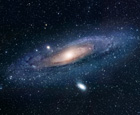
|
M31: This is the Great Andromeda Galaxy, it is very bright, big, and easy to see. When I View M31 I see it get bright in the middle and dimmer outwards from the core. It appears as a big fuzz in the scope and no real detail can be seen. It is a great view, and a great Galaxy to start your first Galaxy hunt with. Heres some directions on how to find Andromeda Galaxy: In the Andromeda Constellation locate Mirach ( a star in the constellation, use a star chart to help know which star this is ) and hop to 37 Mu Andromedae, a fainter star that appears close to Mirach ( also should be in charts) just follow the path these two stars form and you should run into M31.
|

| M32: This is a companion to M31 and appears in the same field of view as M31. It is a small dwarf galaxy and it appears as a fuzzy star that refuses to focus, circular in shape, and easily seen. M32 is the fuzz "star" to the left of M31 in the image. |

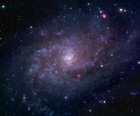
|
M33: This is a very hard to see object and is best viewed when at the zenith. It shines at magnitude 5.5, but is face on, so it is spread over a large area of sky, and is diffuse. Quite elusive in a 4.5 inch scope. I searched for this many times, with no luck. Finally got it while at the zenith, appears a faint haze spread over a fair area of the eyepiece. Dose not seem to get any brighter toward core. Hard to see, but worth tracking down if conditions are right.
|


| M51: The Whirlpool Galaxy, located in the constellation of Canes Venatici. This is a very nice galaxy! It is easily seen in the telescope! This galaxy also has attached compainion! The Companion (NGC 5195) is visible in the same field as M51. M51 appears as circular patch of light in the telescope. This is a very nice galaxy and well worth tracking down! M51 is Magnitude 8.4. |
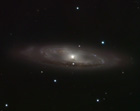
| M65: This is a Magnitude 9.3 Galaxy in the constellation of Leo. It appears as a elongated patch of light. It has a neighboring galaxy (M66) in the same field of view! This galaxy is easily found! In fact, when I pointed the telescope to the general area M65 was in the Field of View! |
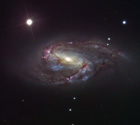
|
M66: M66 is a Magnitude 9.0 Galaxy in the constellation of Leo. There is a star right on the galaxy. It appears as a somewhat oval shape in the telescope. It has a neighboring galaxy (M65) in the same field of view! This galaxy is worth finding and is extremely easy to find!
|

|
M81: This is a bright spiral galaxy, it appears almost as a fuzzy oval like shape in the telescope. Extremely bright core. It is easily seen, but not to easily found. It took me about 5 nights to find this. (I spent about 1-2 hrs searching each night.) It is in Ursa Major, the Bear.
|
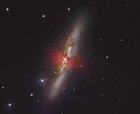
|
M82: This galaxy appears in the same Field of View as M81, also in Ursa Major. This galaxy is fainter than M81, but still easily seen. Averted vision helps when viewing this galaxy, but I can also be viewed directly easily. It appears as a thin, smudge of fuzz in the scopes FOV. Perhaps some structure was seen.
|


|
M104: I have observed this galaxy in the 254mm Dobsonian. Upon observation the dark dust band is clearly visible running across the front of the galaxy. It has a very bright nucleus. I was suprised at how small the galaxy was. I was expecting it to be bigger in size. However, it is still a great target and one of the best objects to observe in the sky.
|
M108: This is a fairly faint Galaxy in the constellation Ursa Major. It appears as a elongated patch of light through the telescope. It is Magnitude 10.1 and the Owl Nebula (M97) is close by. Easily found, it is close to the bright star Merak.
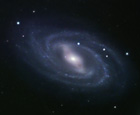
|
M109: I have only observed this galaxy in the 254mm Dobsonian. It was fairly bright and fairly easily seen. It is located in the "dipper section" of Ursa Major. The bright star Phecda is close to this galaxy. I used enough magnification (25mm) 48x to keep the star out of the field of view when viewing the galaxy. It appeared to be slightly elongated in shape.
|

| M110: This is a fairly easily seen Galaxy around Andromeda. It took me a while to find this one, but once you see it... you can't miss it. It adds alot to the view around M31, as you have M31, M32, and M110 right there. It is Magnitude 8.0 and appears as a faint elongated patch of light in the telescope. M110 is the elongated patch of light below M31 in the image. |

| NGC 5195: This is the compainion galaxy to M51. It appears as a small circular patch of light close to M51. It is magnitude 9.6 and is in the constellation of Canes Venatici. NGC 5195 is the galaxy to the left in the image. |